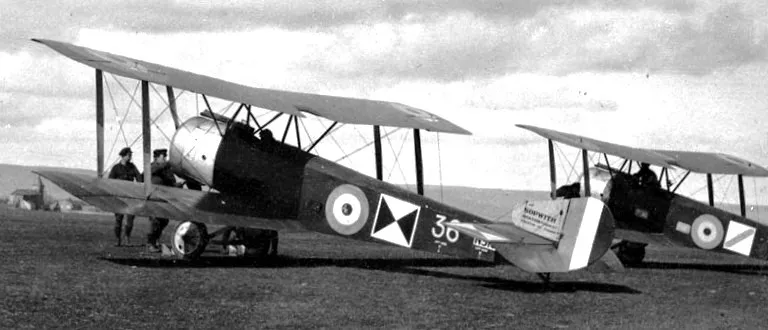Sopwith 1 1/2 Strutter

(Source Harold A Skaarup web page)
The Sopwith 1/2 Strutter was a British single- or two-seat multi-role biplane aircraft of the First World War.[1] It was the first British two-seat tractor fighter and the first British aircraft to enter service with a synchronised machine gun. It was given the name 1/2 Strutter because of the long and short cabane struts that supported the top wing. The type was operated by both British air services and was in widespread but lackluster service with the French Aéronautique Militaire.
Sopwith 1½ Strutters, No. 3 Wing, Royal Naval Air Service (RNAS), Luxeuil, France, Sep 1916. The Wing was commanded by Capt. W.L. 'Daddy' Elder, and contained a large proportion of Canadian pilots, not because of any conscious decision to do so, but because the large contingent of Canadians that had joined the RNAS were just now coming out of flying school and were available for service.
On 12 October 1916, a raid on the Mauser works at Oberndorf was carried out by 22 British and between 21 and 34 French aircraft. The British contributed nine Sopwith bombers, six Breguet V bombers and seven Sopwith fighters. While the French force comprised 12 Farman F.42, seven Breguet IV, one Breguet V and one Sopwith fighter (both borrowed from the RNAS). In addition four Nieuport 17s of Escadrille N.124, the 'Escadrille Americaine' provided an escort.
The force lost a total of three British and seven French machines. One of the pilots lost on the raid was F/S/L C.H.S. 'Charlie' Butterworth, a Canadian from Ottawa. He was flying Sopwith bomber (Serial No. 9660) when he was forced down with a slight wound to his neck and damage to his engine after an attack by a Fokker D.II flown by Vzfw Hanstein. Fortunately, Butterworth was able to land on an airfield at Freiburg and was taken prisoner.
The RFC was undergoing a shortage of aircraft and one solution to bring the RFC up to size was the transfer of RNAS squadrons to RFC control. Therefore at the end of January 1917, Capt. Elder was directed to send nine of his best pilots to Dunkirk. These were to be the nucleus of the newly formed No. 3 (N) Sqn RNAS which was being sent to assist the RFC. Pilots in this first group included H. E. Wigglesworth, F. S. L. Cotton, plus the Canadians F. C. Armstrong, R. Collishaw, J. S. T. Fall, J. A. Glen, P. G. McNeil, J. J. Malone and A. T. Whealy. (Bob Pearson) Wikipedia and Harold Skaarup web page
last update: 2023-04-11 22:11:58PC — Ctrl-F
Mac — ⌘-F
Mobile —


 Strutter
Strutter Wikipedia Strutter
Wikipedia Strutter Harold A Skaarup Web Page
Harold A Skaarup Web Page